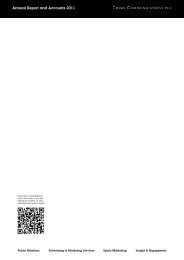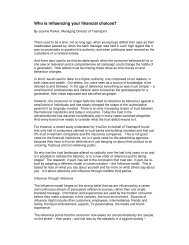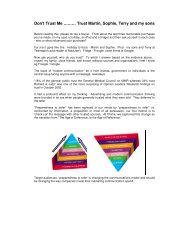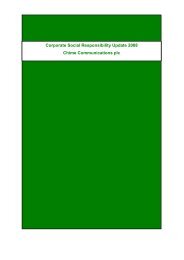Full-year - Chime Communications PLC
Full-year - Chime Communications PLC
Full-year - Chime Communications PLC
Create successful ePaper yourself
Turn your PDF publications into a flip-book with our unique Google optimized e-Paper software.
Notes to the consolidated financial statements2. Significant accounting policies (continued)Impairment of property, plant and equipment and intangible assets excluding goodwillAt each balance sheet date, the Group reviews the carrying amounts of its tangible and intangible assets to determine whether there is anyindication that those assets have suffered an impairment loss. If any such indication exists, the recoverable amount of the asset is estimated inorder to determine the extent of the impairment loss (if any). Where the asset does not generate cash flows that are independent from other assets,the Group estimates the recoverable amount of the cash-generating unit to which the asset belongs. An intangible asset with an indefinite useful lifeis tested for impairment annually and whenever there is an indication that the asset may be impaired.Recoverable amount is the higher of fair value less costs to sell and value in use. In assessing value in use, the estimated future cashflows arediscounted to their present value using a pre-tax discount rate that reflects current market assessments of the time value of money and the risksspecific to the asset for which estimates of future cash flows have not been adjusted.If the recoverable amount of an asset (or cash-generating unit) is estimated to be less than its carrying amount, the carrying amount of the asset(cash-generating unit) is reduced to its recoverable amount. An impairment loss is immediately recognised as an expense in the income statement.Where an impairment loss subsequently reverses, the carrying amount of the asset (cash-generating unit) is increased to the revised estimate of itsrecoverable amount, but so that the increased carrying amount does not exceed the carrying amount that would have been determined had noimpairment loss been recognised for the asset (cash-generating unit) in prior <strong>year</strong>s.Work in progressWork in progress is stated at the lower of invoiced cost and net realisable value, net of payments received on account. Cost represents worksupplied from outside the Group awaiting billing to clients at the <strong>year</strong>-end and directly attributable overhead costs.Financial instrumentsFinancial assets and financial liabilities are recognised on the Group’s balance sheet when the Group becomes a party to the contractual provisionsof the instrument.Cash and cash equivalentsCash comprises cash, overdrafts and cash held on short-term deposit (up to three months). Cash equivalents are cash deposits held on threemonths deposit at the Royal Bank of Scotland plc. The deposits guarantee the loan note creditors. Interest accruing on the deposits is payable tothe holders of the loan notes less any costs arising.Trade receivablesTrade receivables do not carry any interest and are stated at their nominal value as reduced by appropriate allowances for estimatedirrecoverable amounts.InvestmentsInvestments are recognised and derecognised on a trade date where a purchase or sale of an investment is under contract whose terms requirethe delivery of the investment within the timeframe established by the market concerned, and are initially measured at cost, includingtransaction costs.Investments are classified either as available for sale, and are measured at subsequent reporting dates at fair value, or at amortised cost, where nofair value is readily determinable. Gains and losses on available for sale financial assets arising from changes in fair value are recognised directly inequity, until the security is disposed of or is determined to be impaired, at which time the cumulative gain or loss previously recognised in equity isincluded in the net profit or loss for the period.Bank borrowingsInterest-bearing bank loans and overdrafts are recorded at the fair value of proceeds received, net of direct issue costs.Trade payablesTrade payables are not interest-bearing and are stated at their nominal value.Equity instrumentsEquity instruments issued by the Company are recorded at the fair value of proceeds received, net of direct issue costs.Share-based paymentsThe Group has applied the requirements of IFRS 2 Share-based Payments. IFRS 2 has been applied to all grants of equity instruments after7 November 2002 that were unvested as of 1 January 2005.The Group issues equity-settled share-based payments to certain employees. Equity-settled share-based payments are measured at fair valueat the date of grant. The fair value determined at the grant date of the equity-settled share-based payments is expensed on a straight-linebasis over the vesting period, based on the Group’s estimate of shares that will eventually vest and adjusted for the effect of non-market-basedvesting conditions.Fair value is measured for all schemes with market-based conditions by use of the Monte Carlo model. For all other schemes, fair value ismeasured by use of the Black-Scholes model. The expected life used in the model has been adjusted, based on management’s best estimate, forthe effects of non-transferability, exercise restrictions and behavioural considerations.Annual Report & Accounts 2008 57









